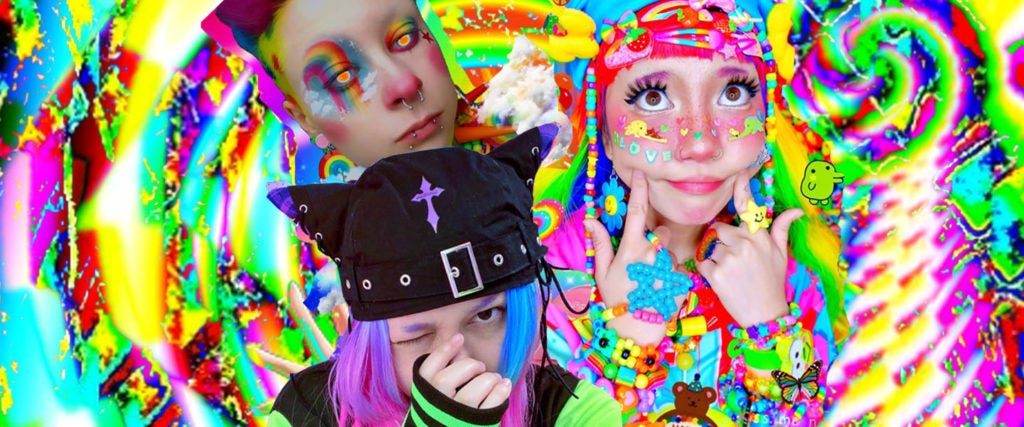They shine bright in a dull, dreary world. They call Froot Loops fashion. They live through the lens of a kaleidoscope. They are “Rainbowcore,” a lifestyle in which participants present themselves as human rainbows, making colorful style choices to illuminate the drab world around them.
If you think it seems childish, Rainbowcore disciples would gleefully agree — bending style norms is kind of the point. Join us as we chase rainbows to the pot of glittery gold that is Rainbowcore fashion.
What defines the Rainbowcore aesthetic?
As Rainbowcore enthusiast Ariel Cassidy explains, “Rainbowcore is exactly what it sounds like: An aesthetic that revolves entirely around rainbows!” Anything goes, so long as loads of colors are involved — even if that means putting glossy stickers all over your face.
In addition to dyed hair and colorful clothes, like tie-dye, nick-nacks are a staple of Rainbowcore: Many believers collect multicolored Kandi bracelets, rings, necklaces, dolls and other wildly chromatic goodies. It can be surprisingly accessible, because most of the accessories are cheap, plastic trinkets you can find at the Dollar Store.
Where did Rainbowcore fashion come from?
Well, Rainbowcore is a comprehensive name for a whole spectrum of excessively colorful aesthetics. “There are actually very similar aesthetics that Rainbowcore often falls into, and vice versa,” Cassidy explains. “They are Kidcore, Clowncore, Scenecore, Webcore and Decora Kei. Each aesthetic is unique in its own way, but for the most part, they’re all very colorful.”
Many of these aesthetics can be traced back to the last one Cassidy mentioned: Decora Kei, a Japanese style that involves extreme decoration, including heaps of accesories. Japanese singer Tomoe Shinohara is believed to have popularized Decora Kei in the 1990s due to her notably flamboyant fashion sense. FRUiTS fashion magazine in Japan covered the look during that time period, when Decora Kai was considered to be punk — FRUiTS mainly covered subcultures, and in Japan, many excessive styles have sprung up as a rebellion against traditional norms. Likewise, influential Rainbowcore brands, like 6%DOKIDOKI, popped up in the 1990s and called themselves “shockingly Kawaii,” or fashionably exaggerated.
These days, many people simply stumble upon Rainbowcore on TikTok or Instagram thanks to their love for colors and an unwillingness to abide by current fashion norms, which are both essential parts of being Rainbowcore. “For me, ever since I was little, I just loved bright things,” Cassidy says. “As I got older, I got more into dressing colorfully, which eventually led to going all out with colors in everything I wear.”
What do Rainbowcore devotees like about Rainbowcore?
“The main reason most of the Rainbowcore fanatics love having their looks revolve around rainbows is because it’s something that makes us feel happy to look at, especially considering how bland this world can be sometimes,” says Cassidy. “Whenever I go out somewhere, I almost always have people telling me how much they love how colorful I am and that it makes them so happy. I love that I can be myself and wear what I love, meanwhile spreading positivity to others without even realizing it! That in and of itself makes me feel joyful, knowing that my bright colors and positivity are radiating onto other people.”
Other than being mega-bubbly, what does a Rainbowcore lifestyle look like?
“Besides the way we look, Rainbowcore people’s lifestyles aren’t very different from everyone else’s,” Cassidy says. “There isn’t anything we do or don’t do that anyone else does or doesn’t do. We just go about our day-to-day lives, but I’d say the only thing is it probably takes us a lot longer to get ready!”
I can only imagine.

